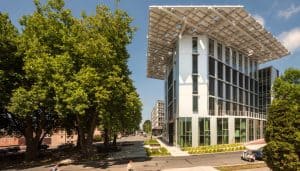GREEN Building

A net zero building uses on-site renewable energy and ensures increased energy efficiency, so the building is energy independent (producing as much energy as it consumes).
Net Zero Construction
article by Kiara
Building construction is, by and large, a carbon-intensive process. Our integrated supply chain means that construction materials are being shipped from place to place. Heavy machinery has yet to go electric. As such, it’s almost impossible to construct a building without emissions.
We can, however, construct buildings that function without relying on fossil fuels - buildings with net zero energy consumption. In this piece, we’ll analyze what net zero building construction looks like, and which sources of renewable energy can be used.
What is a net zero building?
Net zero buildings are any buildings that only consume the energy they produce renewably. This means that there are two ways buildings that have already been constructed can achieve net zero status:
- Increase renewable energy production to the extent that it completely covers the building’s energy consumption
- Lower energy consumption to bring it in line with the building’s current renewable energy production
Practically speaking, the problem should be tackled from both sides. Energy consumption should be reduced while renewable energy production is ramped up. In the rest of this article, we’ll cover construction techniques that can be used to reduce energy consumption, as well as the key barrier to net zero buildings - the policies of electric utilities.
Net zero construction techniques
The vast majority of a home’s energy costs come from its heating and cooling requirements. Fortunately, there are a number of construction techniques that can be employed to reduce a home’s reliance on heating and cooling appliances.
The first is an insulation technique sometimes referred to as superinsulation. By insulating a building sufficiently, builders can almost eliminate heat transfer. This can lead to the home being cooler in the summer and warmer in the winter. In climates with more extreme weather, superinsulation is often coupled with a heat pump. Additionally, energy recovery ventilation (ERV) is used to avoid stale air - superinsulation impedes airflow.
Location and design are essential to net zero construction. Take, for example, passive solar home design. You’ll want to choose a location with an unobstructed view of the sun, as well as south-facing windows (in the Southern Hemisphere, use north-facing windows instead). The home can then be constructed using masonry, like brick, stone, and tile. The sun’s rays will penetrate through the window and heat the masonry. Heat travels through masonry rather slowly, however, and the heat that was trapped in the masonry will be released hours later, heating the building well into the night.
There are also a number of approaches used for passive cooling - they, too, rely on building design. Cross ventilation and stack ventilation can both encourage airflow through a home - though this technique does not pair well with superinsulation. Builders can also limit heat gain by restricting the use of masonry throughout a home, and using lighter-colored exterior materials.
Earth sheltering is another construction technique that’s gaining popularity. By banking earth against a building’s exterior walls, or building into a slope or underground, the earth can act as a thermal mass, cooling the home during the day and warming it at night. There are a number of challenges related to earth sheltering, however - these include the cost of materials, which must be able to support the earth’s weight, and the cost of labor.
A number of other techniques can be used in creating net zero buildings. Energy-efficient lighting is one such technique. By employing LED lights, optimizing natural light, and avoiding recessed lights, lighting costs can be reduced.
Designers can also locate water heaters near areas that will require hot water, such as showers, and use hot water recirculation systems. Energy-efficient appliances are also very important to reduce power usage.
There are several other net zero construction techniques we haven’t covered - materials are a key concern, and things like triple-glazed windows are a must. For now, however, we’ll move onto renewable energy.
Renewable energy and building construction
Renewable energy is becoming more affordable, and it’s an essential part of net zero construction. Owners of sizable commercial enterprises can opt for large-scale renewables - some may even have access to wind or hydroelectric resources. For most buildings, however, solar is the best option.
Properties can be maintained to optimize solar intake. Solar panels should point facing south (or north in the Southern Hemisphere). The panels should be built without obstructions. To improve solar intake, a tracking system can be employed.
The main problem with solar as a renewable, however, is that the sun goes down - and when it does, solar energy goes with it. This problem can be resolved through net metering - solar energy producers sell their energy to utilities, who then credit them. Use the utility’s power at night, and the building’s power during the day.
Net metering can be used to achieve net zero, but only with the cooperation of utilities. Solar batteries are improving, but they can only get us so far. We hope that, through legislation and popular demand, all utilities will begin to use net metering.
About the author: Kiara is a part of the marketing team at Quik-Therm Insulation. Quik-Therm provides commercial roof insulation solutions that are environmentally responsible, require fewer components, install faster, and cost less.